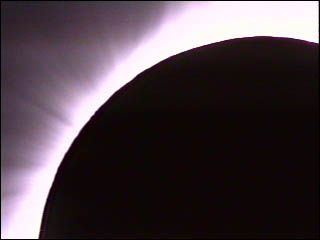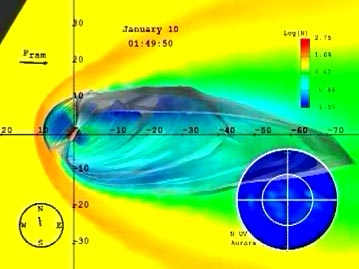 |
| A close-up
of the Sun's corona. Image taken during a 1998
total solar eclipse over the Caribbean. ©The
Exploratorium. |
|
All you have to do is look at a picture
of a total solar eclipse and it is pretty obvious that the
Sun's influences do not stop at its surface. For much of the
20th century, astronomers have suspected that the outer atmosphere
of the Sun, called its corona, is not the end of the line.
By the 1950s, it was pretty clear from studying mathematical
models of systems such as stars, that a corona is not stable.
It has to be constantly leaking away into space like the steam
rising from a pot of boiling water. Astronomers called this
constant outflow of gas from the Sun the solar wind. It took
the technological advances of the Space Age to confirm this
flow of particles in the early 1960s. Since then, astronomers
and space scientists have learned a lot about this wind, and
the winds from other stars too!
Hot Corona
One of the biggest mysteries about
the Sun has been why the corona is so hot. The surface of
the Sun has a temperature of about 6000 Centigrade, but the
temperature of coronal gases is over 1.2 million Centigrade.
How is it possible that the Sun's atmosphere is hotter than
its surface? This would be like the steam rising from a pot
being hotter than the pot that is creating it. The answer
seems to have to do with the constant creation and destruction
of magnetic loops of energy all across the surface of the
Sun. This magnetic energy, when released, seems to be more
than enough to keep the corona hot. It also provides the energy
that is needed to drive the solar wind and propel it into
the depths of the solar system at speeds of 450 kilometers/second.
At these speeds it takes about 150 days for it to reach the
orbit of Pluto.
 |
A
computer simulation of the solar wind impacting
the Earth's magnetosphere. Movie courtesy
of University of Maryland
Advanced Visualization Laboratory.
(Click
to launch movie.)
|
|
|
Blowing in the Wind
The solar wind travels at about
450 kilometers/second but can gust up to 1,700 kilometers/second
or more if there is a powerful coronal mass ejection passing
by. The solar wind is composed the same atoms that make up
the Sun itself, and in nearly the same abundances. For example,
out of 100 atoms in the wind, there are about 75 hydrogen
atoms for every 23 helium atoms. Eventually, the solar wind
collides with atoms from interstellar gases surrounding the
solar system out beyond Pluto, forming a shock front and a
vast, but invisible, bubble.
The solar wind is like a conveyor belt
that transmits the outcomes of events on the solar surface
into interplanetary space. It can carry both particles and
magnetic fields that were formerly a part of the solar surface.
When this wind encounters a distant planet, it causes changes
in the electrical properties of the space around the planet
that can have significant impacts on planetary atmospheres
and especially on their own magnetic fields, if they have
one. Venus and Mars bear the full brunt of the streaming wind,
and lose some of their atmosphere into the wind. Other planets
such as the Earth, Jupiter, Saturn, Uranus and Neptune have
powerful magnetic fields of their own, which act as shields
for much of the solar wind's forces.
 Find out more about the Sun-Earth Connection at the Sun-Earth
Connection Education Forum Web site.
Find out more about the Sun-Earth Connection at the Sun-Earth
Connection Education Forum Web site.
Text adapted from the
Sun-Earth Connection Tutorial courtesy of NASA, originally
written by Dr. Sten Odenwald. Images and videos courtesy of
NASA unless otherwised noted.
|